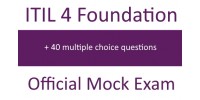Problem Management
Objective
To investigate the root causes of (recurring) incidents in order to avoid future recurrence of incidents by resolving the underlying…
To investigate the root causes of (recurring) incidents in order to avoid future recurrence of incidents by resolving the underlying problem, or to ensure workarounds / temporary fixes are available
Activities: Initial Process Setup
Define a standardized and repeatable way to record problems, known errors and related workarounds, and set up an initial known…
- Define a standardized and repeatable way to record problems, known errors and related workarounds, and set up an initial known error database (KEDB).
- Set up a tool (e.g. ticket / workflow tool) supporting the recording and handling (including classification, prioritization, escalation, closure) of identified problems
Process Inputs
Statistics on incidents and service requests (for trend analysis) Incident and service request records Other relevant sources of information to…
- Statistics on incidents and service requests (for trend analysis)
- Incident and service request records
- Other relevant sources of information to identify (new) problems, including change and release records
- Configuration information (CMDB)
Activities: Ongoing Process Execution
Perform regular incident trend analysis to identify (new) problems Manage problems Identify and record a problem Classify a problem Prioritize…
- Perform regular incident trend analysis to identify (new) problems
- Manage problems
- Identify and record a problem
- Classify a problem
- Prioritize a problem
- Escalate a problem
- Resolve a problem
- Close a problem
- Maintain the KEDB
- Add a known error (and workaround) to the KEDB
- Update a known error (and workaround) in the KEDB
- Remove a known error (and workaround) from the KEDB
- Perform a KEDB review
Process Outputs
Up-to-date KEDB with information (records) on problems, known errors and related workarounds Requests for changes raised to trigger the change…
- Up-to-date KEDB with information (records) on problems, known errors and related workarounds
- Requests for changes raised to trigger the change management process, in order to resolve the underlying root cause(s) of identified problems / known errors







